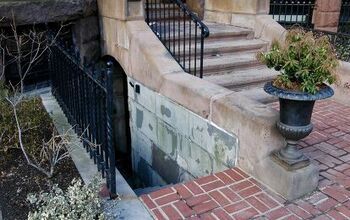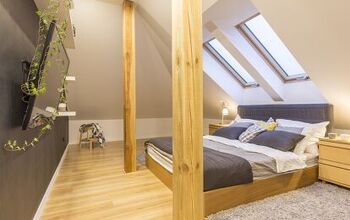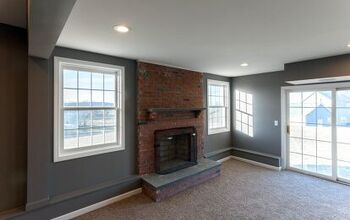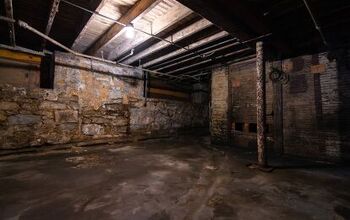What Is A Partial Basement? (Find Out Now!)

It can be difficult to know which basement type to go for with your new home. Whether it be a crawlspace, cellar, full or partial basement, they all differ in cost and functionality. You’ve probably heard of a full basement but might be wondering: what is a partial basement?
A partial basement is a basement that extends only a portion of the area of a home. Some are fully underground, while others are excavated partially above ground as daylight basements. Partial basements are uncommon but cheaper to construct than full basements and can be turned into living spaces that add property value to the home.
Do You Need Basement Remodeling Services?
Get free, zero-commitment quotes from pro contractors near you.

What Does a Partial Basement Look Like?
Partial basements are typically constructed with a cement foundation, a crawlspace, cinder block walls and exposed beams. They can also be excavated partially above ground. This makes them perfect for installing windows and exterior doors.
Some homeowners choose to leave their partial basement unfinished. Others remodel it by adding furniture, curtains, shelves, and floating floors. This transforms a partial basement into a bright and integrated living space.
Should I Build a Partial Basement?
The best basement for you will depend on your home’s foundation and land plot. With high-water tables or rock ledges, many homeowners choose a partial basement. House structure also matters. Split-level homes and raised ranches are ideal for building partial above ground basements.
If you want storage, shelter, and functional living space, partial basements are a great option. Smaller homes will benefit from the added storage and square footage. Larger homes will benefit from cost-efficiency, as excavating a full basement is more expensive.
Partial basements are often constructed into daylight or walkout basements. Since part of the basement is built above ground, windows and exterior doors can be installed. Homeowners will turn these into living rooms, studios, or in-law suites.
Difference Between Partial and Full Basements
The main differences between partial and full basements relate to building costs and layout. Full basements are totally underground. They also cover the entire dimensions of the structure above them. Partial basements can be fully or partially underground. They only extend a portion of the area of the home.
Constructing a partial basement is more cost-effective than a full basement. Builders will not have to dig out the full home dimensions. This brings down labor and materials costs.
Keep in mind that just like full basements, construction costs are still considerable. Full basements may offer more bang for your buck. Take a look at the difference between cellars and basements.
Pros and Cons of a Partial Basement
While basements can be pricey to construct and renovate, they are usually worth the investment. Basements offer shelter, storage, and a multi-purpose living space. When finished they add significant property value to a home.
There are pros and cons to any type of basement you choose. If you’re struggling to decide on building a partial basement, you’re not alone. Let’s dive into the pros and cons of why a partial basement might be a good option.
Partial Basement Pros
Partial basements are a low-cost alternative to full basements. They do not extend the full home dimensions, requiring less labor and materials to build. They provide the storage and shelter of traditional basements without the full price-tag.
Next, partial basements are blank canvases for being remodeled into living spaces. Many are partially above ground, allowing for conversion into a daylight basement. This greatly increases the property value of the home.
- Affordable alternative
- Adds square footage
- Underground storage and shelter
- Can be finished as a living space
- Partially above ground
- Increases property value
Partial Basement Cons
While the benefits are clear, partial basements have downsides. While cheaper than full basements, foundation, labor and materials costs are still considerable. Digging out a crawl space or constructing a finished daylight basement can cost anywhere between $50,000 – $150,000.
Next, a partial basement isn’t as spacious as a full basement. This means less storage and living space renovation opportunities. It is also prone to flooding. And if the basement is a walkout or daylight, it is more susceptible to the natural elements and break-ins.
- Expensive foundation and renovation costs
- Less storage space than full basement
- Prone to flooding and moisture damage
- Vulnerable to seasonal changes, break-ins
Ideas for Finishing Your Partial Basement
What makes partial basements nice is their potential. You can transform your unfinished basement into anything your heart desires. Popular ideas include living rooms, entertainment centers, art studios, workshops, laundry rooms, or in-law suites.
It’s important to research local building codes first. If there are no roadblocks, apply for the appropriate permits before doing construction. Then get inspired by these creative ideas for finishing your partial basement!
- Install drywall or paint the existing walls. Sprucing up the walls in your partial basement adds a homier, brighter feel and more dimension. Strategic drywall placement can create dimension by zoning different sections of the area. If you don’t want to invest in drywalling, paint your cinder block or cement walls a bright color. White is ideal because it makes the basement feel larger and sunlit.
- Hang up curtains. Curtains are perfect for zoning new spaces to create the illusion of separate rooms. They can also add a personal, decorative touch to your living space. Use them to strategically cover up your washier and dryer, storage bins, or crawl space.
- Lay down a floating floor. Most partial basements are built with cement floors, which aren’t the most attractive. Consider installing floating flooring to cover it up. Laminate, vinyl, engineered wood, and foam square mats are some popular materials. Floating floors don’t require adhesion to the subfloor and link together like puzzle pieces for easy installation.
- Hang up string lights. String lights are cheap and magically transform any drab space. Hang them over doorways, windows, and walls to create a warm, inviting glow.
- Add furniture and décor. Want your basement to be a functional, comfy living space? Furniture is a necessity. Turn it into any kind of room with some basic furniture and decorations. Many homeowners design living rooms, bedrooms, entertainment centers, workshops and in-law suites.
- Place area rugs. If you’re not going the floating floor route, area rugs are essential. These add character and warmth to a partially finished basement. They also improve the appearance of cement flooring. Area rugs go great in a finished living room or bedroom-style basement.
- Install windows and a glass exterior door. Have a daylight or walkout basement? Consider investing in windows and a full glass exterior door. Daylights or walkouts are partially above ground, making them accessible to the outdoors. Letting in more natural light and air optimizes the living space.
This kind of renovation really increases the value of the house. Keep in mind, exterior door installation alone will cost between $2,500-$10,000.
- Set up your own studio or workshop. The beauty of a partially finished basement is that you have freedom to get messy. Instead of completely finishing it, turn that unsightly corner into your own studio or workshop. With a studio table, shelving, and cabinets, you’ll be spilling paint in no time.
How to Expand a Partial Basement
Partial basements are partially finished, partially unfinished. The unfinished portion usually consists of a crawl space. It is possible to expand a partial basement into a full basement by digging out the crawl space. This is around $50 per square foot and will total between $20,000-$70,000.
These full expansion costs are considerable for most homeowners. Many contractors recommend adding an above-ground addition to your home. This adds the square footage you’re looking for without as high a price. Have you ever wondered why California doesn’t have basements?
Related Questions
What is a Crawl Space?
A crawl space is an unfinished, shallow area under the home for wiring and plumbing access. These spaces are built off the ground and allow air to vent beneath the house. Crawl space foundations are more cost-effective than basement foundations. They are also convenient for installing HVAC systems and plumbing.Crawl spaces are unfortunately susceptible to moisture damage. They are found in many partial basements and can be dug out and converted into a full basement.
What are the Types of Home Foundations?
There are three main types of home foundations: concrete slabs, basement foundations, and crawl space foundations. Their unique benefits are based on affordability, convenience, and functionality.Basement foundations are often the preferred foundation. They are best for adding square footage and converting into useful living spaces.
Do You Need Basement Remodeling Services?
Get free, zero-commitment quotes from pro contractors near you.

What Did We Learn?
A partial basement is a basement that extends only a portion of the structure above it. They can be either fully underground or partially above ground. Partial basements are commonly found in split-level or raised ranch homes. These can be converted into daylight or walkout basements.
A partial basement provides storage and shelter without the hefty price tag of a full basement. They are often partially above ground. Their access to the outdoors makes them perfect for renovating into furnished living spaces. These remodels are often costly but can seriously up the sale value of a home.
Related Articles

We are a team of passionate homeowners, home improvement pros, and DIY enthusiasts who enjoy sharing home improvement, housekeeping, decorating, and more with other homeowners! Whether you're looking for a step-by-step guide on fixing an appliance or the cost of installing a fence, we've here to help.
More by Upgraded Home Team
















![10 Most Dangerous Neighborhoods in Baltimore [Updated]](https://cdn-fastly.upgradedhome.com/media/2023/07/31/9075655/10-most-dangerous-neighborhoods-in-baltimore-updated.jpg?size=350x220)










